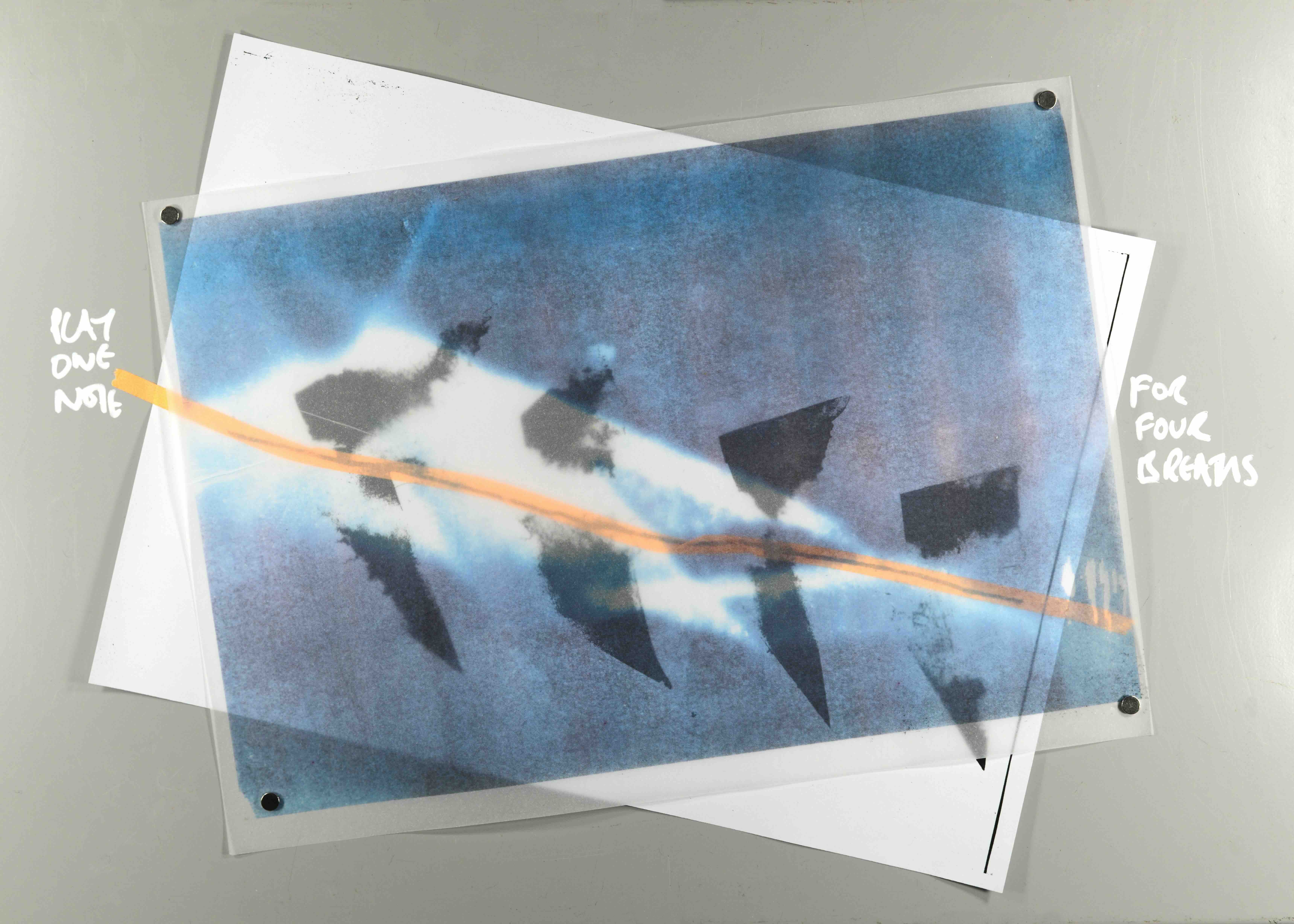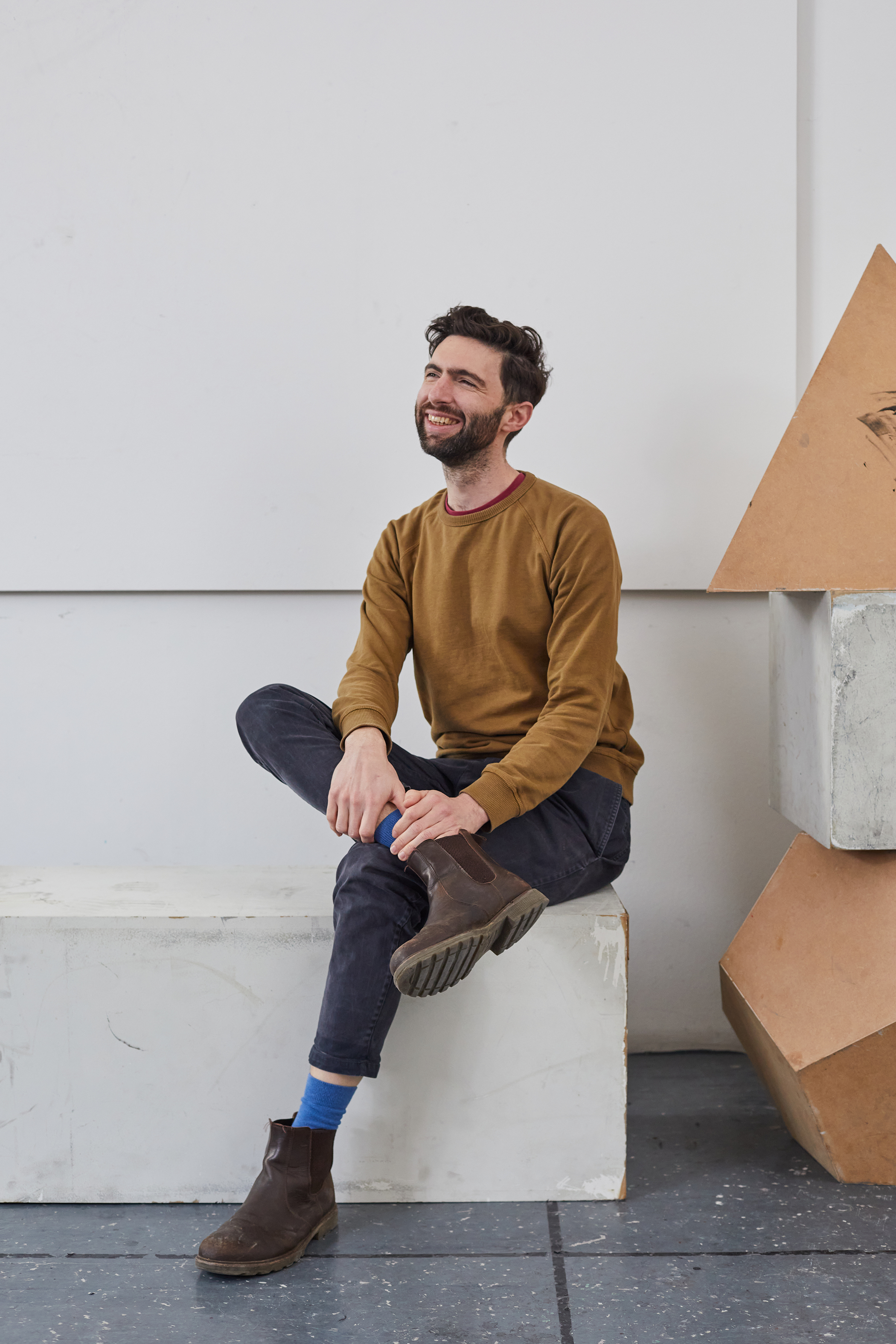Ben McDonnell
‘Coming Apart and Falling Together’
Presented by Apsara Studio
August 14th – 16th, 2025. Apsara Studio, 200 Battersea Park Rd, SW11 4ND London

One note four breaths score, 2025. Image courtesy of Ben McDonnell.
Apsara is proud to present Coming Apart and Falling Together, an artist-led exhibition by Ben McDonnell, a visual and sound artist, as well as an academic. The project draws inspiration from impermanent structures that facilitate collaboration. The work occupies an in-between space that bridges sound practice, installation and the social practice of teaching and learning. The multi-channel film and spatial audio installation in the exhibition are based in Ben’s PhD research and art practice(s). Graphic scores, multichannel sound and video installation, sculpture and photographic images are drawn together to think about listening, learning and the body.
Ultimately, Coming Apart and Falling Together asks how we can propose structures based on listening, resonance and rhythm that are rigid enough to be supportive, while being open enough to leave space for the unexpected and the transformational.
Ben McDonnell Interviewed by APSARA
“Using a sonic practice to re-think or re-visit the pedagogic spaces I work in allows me to listen to what is happening in a new way rather than rely on doing what has been done before, repeating structures and dialogues that don’t work particularly well.”

Ben, we’re thrilled to be hosting ‘Coming Apart and Falling Together’ in our newly inaugurated project space at Apsara. As an artist-led exhibition that has emerged from your PhD at Goldsmiths, how has that research shaped the project, both conceptually and spatially?
Thanks! I am excited to be sharing this work at Apsara Project Space – the space is beautiful, and it supports my work really well.
I am at the halfway point in my PhD at Goldsmiths, based in the Centre for Arts and Learning. My practice based research draws on my sound and arts practice to critically look at, and listen to, the tacit, hard-to-see structures in art education. This work allows both students and staff to shape learning that is co-created; focusing on dialogue between people and practices rather than an individualised, ‘collecting knowledge’ model of education. I specifically look at dialogic learning, using the art school staple of the ‘crit’ as a basis for this research.
As a musician I am trained to transcribe an event as a way of understanding it, so I started to transcribe crit sessions as if they were a piece of music. Through doing this I found that some structures were repetitive, and the dialogue was often single sided. However, I also found lots of potential for a richer and more meaningful learning event.
Using the writer Paulo Freire as a guide, I started to think about the conditions for learning and for creating meaningful dialogue. To do this I developed a series of scores, studies or ‘études’ in developing ways of working together. Some of the scores are in the exhibition, the main work of the show is a recording of a performance of these scores.
Rather than requiring musical virtuosity, the scores (made with graphic, image-based notation) are intentionally ambiguous, requiring interaction and collaborative listening to perform them. The works focus on breath, timbre and touch as means of establishing a dialogue.
Spatially, it is important that the work creates an architecture that is inhabited by visitors to the exhibition. When people first come into Apsara there is a 6-channel audio work with panel speakers arranged around the room, and an accompanying 3-channel video work which physically envelops visitors to the exhibition. Installing the work in this way offers an invitation to establish connections with the space the work is in.
Tell us a bit more about your background. How do music, photography, installation, and pedagogy interweave in your practice, and what role does interdisciplinarity play as a driving force in the work?
I studied jazz for my undergraduate degree, while doing this I also started teaching and taking pictures. These practices have developed alongside each other over 20years and I have always seen them as somehow the same. This led me onto completing the photography MA at the Royal College of Art and now to Goldsmiths. The PhD has given me space to more critically explore this intuitive feeling, allowing me to draw from one practice to investigate, expand and rethink the other. I currently have a sound and visual arts practice and teach at Norwich University of the Arts. I see these practices as part of one another, ‘interdisciplinary’ as they are in-between disciplines, each having its own language and canon but I am operating between and drawing on both when I make work. As an example, the timbres and rhythms emergent from compositions I make might alter how I structure teaching and learning. Or something unexpected happening in my teaching might lead me to make an image or develop a score to understand what happened further (the joy of art school is that the unexpected happens a lot!).
You seem particularly interested on rethinking pedagogical spaces through sonic encounters. We are curious to know what new forms of knowledge production and relationality emerge when pedagogy is approached as an auditory experience alongside the visual and the discursive?
Another great question! I think re-thinking is the keyword here. Tim Ingold describes research as re-search, re-visiting the same spaces but seeing (and hearing) them differently each time. Using a sonic practice to re-think or re-visit the pedagogic spaces I work in allows me to listen to what is happening in a new way rather than rely on doing what has been done before, repeating structures and dialogues that don’t work particularly well.
The focus for me now is trying to make spaces that are inclusive (in that they allow for participation with a minimum degree of prior knowledge) while being both supportive and open. I began thinking of the embodied experiences of listening in my practices. This led me to think about breath as a unit of measurement for time – as it is something we all share. However, we all experience breath differently, which leads to the question: can the structures I occupy not only accommodate this but actively require this difference to work? I am also fascinated in the tension between open-ness and support. In a piece of music, the instruction ‘do what you want’ is not all that useful, it doesn’t support the performer. Conversely, a dictatorial score that notates precise instructions for every aspect of the performance leaves little space for anything new, anything radical to happen in its performance. I hope to pull this into my teaching and learning practice – how can we co-create pedagogic events that are supportive for those inhabiting them but also open enough to allow for the rupture and the unexpected?
It seems like the installation invites the audience into the process rather than presenting a fixed outcome. What draws you to this participatory form, and how do you envision the public’s position in affecting and being affected by the work?
Again, I think your choice of words are excellent here. Process and participation are super important for the work I make. I have always been fascinated by the processes that make things work. As an example, I took my mum’s camera apart to see what made it work when I was very young and I don’t think it ever went back together! This manifests as a real joy in the ‘liveness’ and vitality of an ‘in-process art practice’. I love experiencing the emergence, changing, responding and something being figured out in real time, and this is probably what I love about teaching too.
The work is participatory in that I present a process, a work that is both figuring itself out and provokes a questioning in those participating with it. A film that is part performance and part rehearsal, scores that are (intentionally) unsure of what they ask and a sound work that can be experienced differently depending on the position of the participant in the exhibition space. Both the conceptual reasoning behind the work and the material and aesthetic choices I make open spaces that invite conversation and questioning. I would like the public who come to experience the exhibition to share in my pleasure of the aesthetic presentation of the work but also to question, respond and talk about the type of ideas we have discussed here.
Ben McDonnel is an artist, musician and academic. His BA (hons) was in jazz performance and composition at Leeds College of Music. In 2017 he completed an MA in photography at the Royal College of Art. Currently his practice(s) sit between making photographic images, installation, performing with graphic scores as well as teaching. He has received funding for projects from the British Council, Arts Council England and has exhibited internationally. Ben has written extensively about sound and education and has been published by Routledge, Palgrave McMillan, amongst others. He is currently a Senior Lecturer for the Fine Art BA course at Norwich University. In addition, Ben is currently a PhD candidate in Arts and Learning at Goldsmiths UoL.